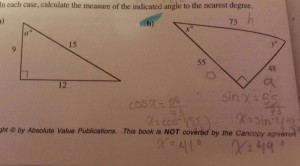This week in Math we finished off working on polynomial operations and started off on factoring polynomials.
(Insert picture here)
For Polynomial Operations, we mainly focused expanding out binomials and eventually trinomials, from there we would use distributive property and solve the equation to how we see fit.
(insert picture here)
For Factoring Polynomials, we just started remembering how to find the GCF and learnt that the opposite of expanding is factoring, we then applied those concepts to solve questions in the workbook.
(insert picture here)
My “a-ha” moment of this week wasn’t necessarily from the new unit, as I already grasp the concept of Polynomials fairly well but moreso on reviewing my Trig test. Before I would normally skim through questions and ignore all logical thinking to just do my calculations, but as it turns out, that shouldn’t be the case. I made an error in which I thought all angles could be used for solving a triangle, I never took into account the 90° angle since it is always there. Needless to say, I failed that question. So, only TWO angles can be used to solve for triangles due to the 90° angle.




